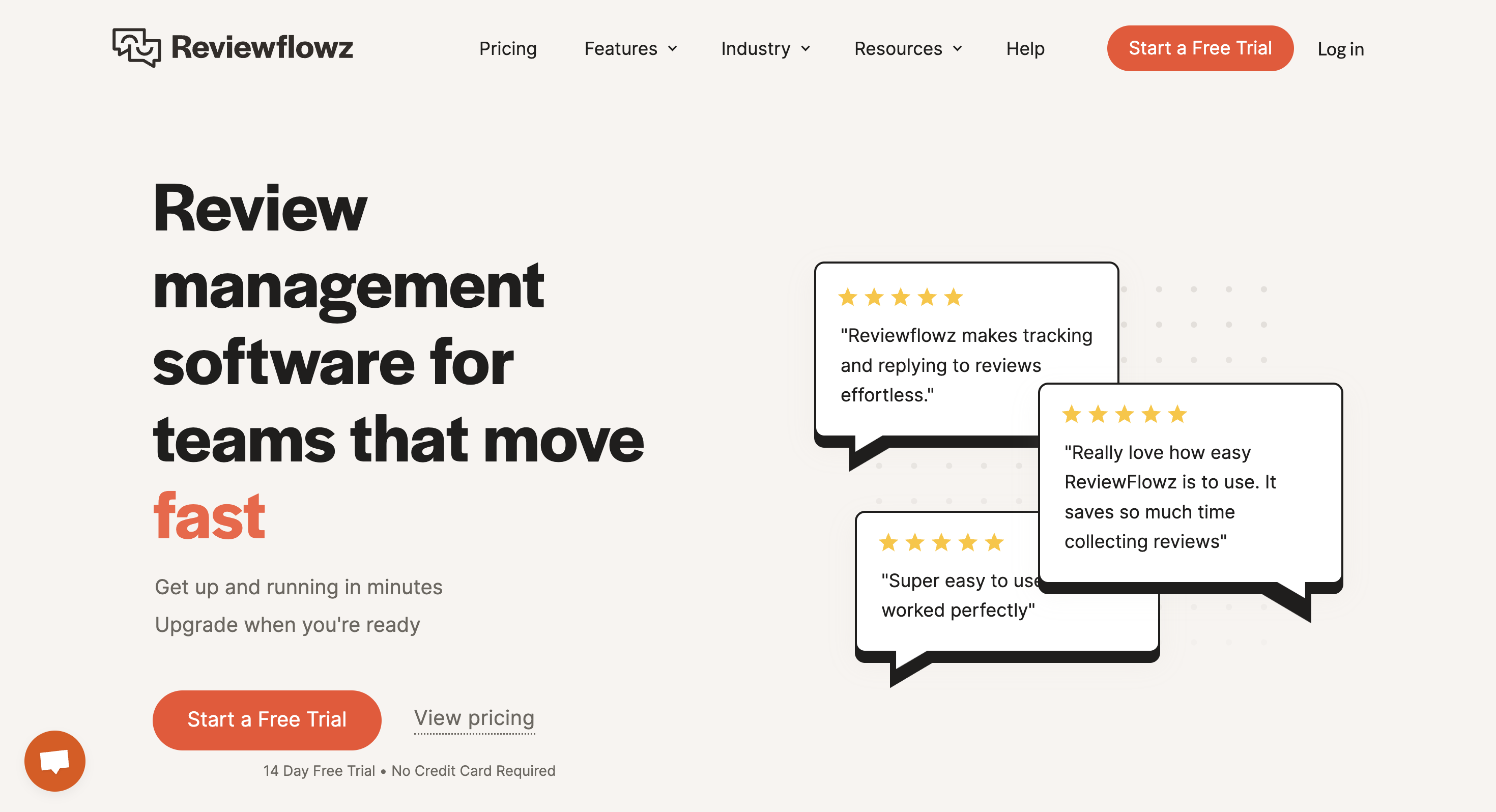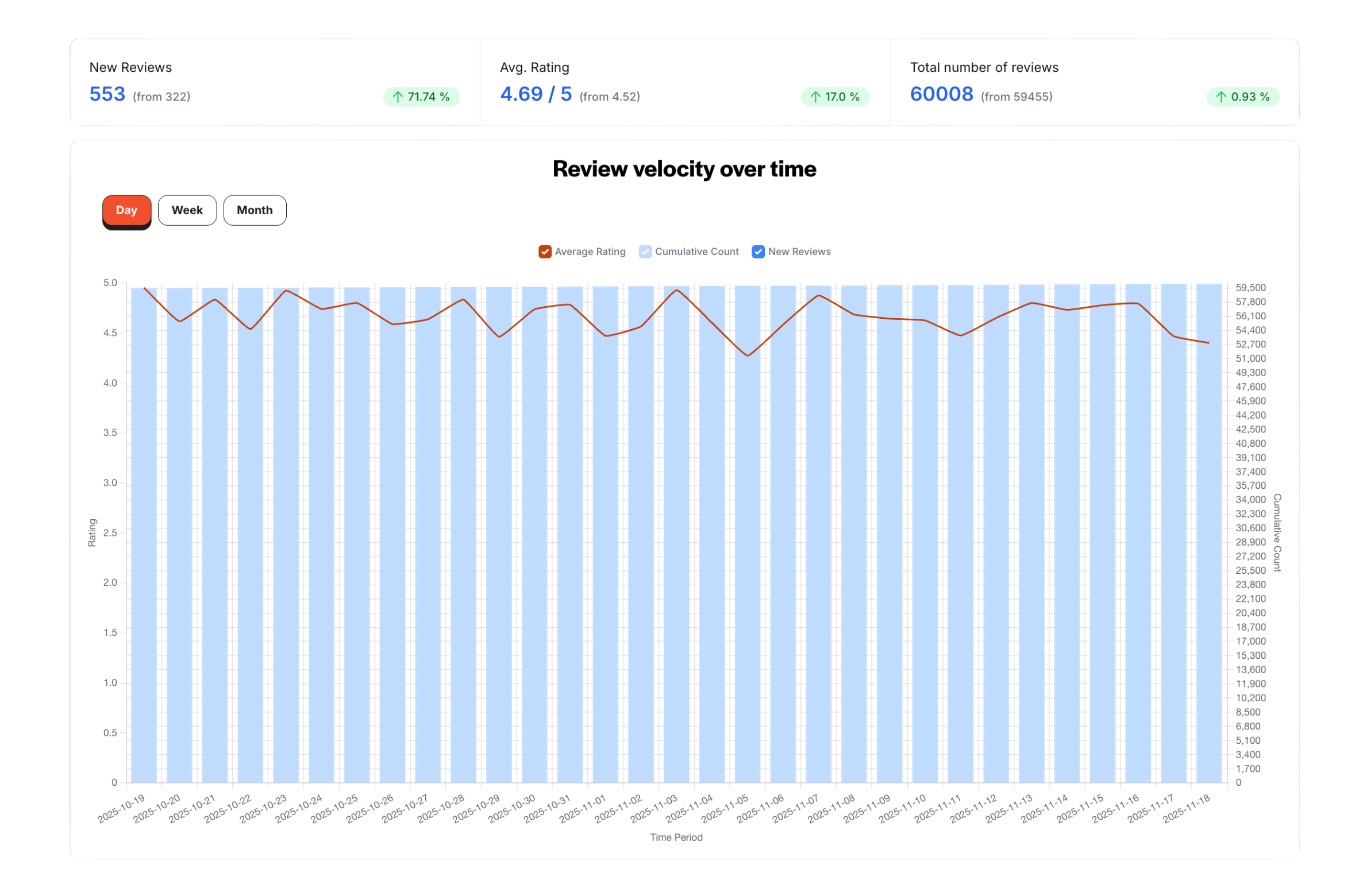Review management is such a broad topic. Most of the review management software on the market is very differentiated, targeting different customer segments with different feature sets and product visions.
In this post, we go through our top 10 selection of review management software.
What to Look for in Review Management Software
- Review monitoring: Review management starts with monitoring. You can’t optimize something you’re not measuring. Review monitoring software lets your team stay on top of new reviews to celebrate successes and address issues as they arise.
- Analytics: Don't settle for a couple of reports hardcoded with no ability to customize the dimensions or metrics to what actually matters to you and your company.
- Review widgets: Displaying your reviews and leveraging the social proof they generate is integral to review management. Look for flexible review widgets you can customize easily, are consistently up to date, and do not affect your website performance.
- Review collection: Most review platforms over-value review recency and will inefficiently blast your customers once a year for a review. You want a consistent stream of positive reviews coming in to build a solid reputation. An efficient review management software will create a constant flow of reviews by leveraging the right triggers to ask for reviews at the right time.
- Reply to reviews: All solutions in this list allow to reply to reviews, the main difference is in how companies handle this, and how far the AI capabilities go. Some solutions don't even have AI implemented, and provide templated responses. Some solutions just offer chat completions, which basically amounts to a conversation with chat GPT without the copy pasting. But some solutions actually do handle context and memory, and provide an easy way to test your AI replies to optimize your prompt. For more on this, check out our dedicated post about AI reply software
- Integrations: Many review management software companies have some sort of "all-in-one marketing software" claim. I'd recommend staying away from those claims, and seeing how the solution actually integrates with your existing software stack. If they don't have an open API, publicly documented, it's a major red flag. Also, look for integrations with modern tools like chat GPT, Claude, Slack, and the Google Suite.
#1 Reviewflowz: Best for modern teams that move fast

Sure, I might be a little biased.
But Reviewflowz is an excellent option for any company looking for a quick and easy software solution to implement.
It comes with a default dashboard with everything you need, but you can also create your own custom dashboards, with your own custom reports, which you can send to anyone over email.

Likewise, the default AI reply agent will get the job done, but you can build your own system with multiple agents replying to different types of reviews, based on their rating, their language, the platform they were posted on etc.
The alerts system is one of the most advanced on the market, with built-in AI translations, and unique integrations with solutions like Slack, Zendesk, Intercom, Google Sheets, etc.
The AI topic extraction feature, and sentiment analysis are widely praised by our clients as one of the most advanced on the market.
.png)
We support virtually every review platform on the market. You can send and track review requests over email, SMS, Whatsapp, or using our magic links & QR codes.
Most importantly, we won't make you sit through a demo if you don't want to.
You can sign-up for a free 14 day trial here, and subscribe, upgrade, downgrade, add or remove profiles at any time from your billing settings.
There's no lock-in of any kind.
We charge per "review profile" so you don't have to pay for listings you don't need. A Review profile is a public review page for a product, location, or brand. For example, your local hairdresser on Google My Business, Instagram on the App Store, or reviewflowz on G2.
If you do need to talk to someone, please feel free to book a call with our founder Axel here.
You can also read more about our pricing here.
#2 Birdeye: Best for Enterprise Franchise Businesses

Birdeye is focused on helping local businesses with reputation management and growing revenue.
This software helps collect reviews, message customer leads, and has a strong customer referral feature.
Birdeye has integrations, so your new reviews and messaging capabilities are seamlessly incorporated into your workflow.
It also integrates with Google’s private API to gain Google direct reviews from customers.
Birdeye’s Standard plan is $299/month and offers features such as review monitoring for over 150 sites, social sharing, and integration with Google My Business.
The Professional plan is $399/month and includes all the same features as Standard plus webchat features.
Birdeye also offers custom plans based on the number of locations and business needs.
#3 Podium: Best for Brick & Mortar Mid-Market B2B Companies

Podium is an all-in-one review management software. It offers growth, customer communication, and payment features for your business, making it a popular option. Podium has an excellent review generation engine and text marketing features.
The dashboard is incredibly easy to use and centralized.
Podium’s Essentials plan ($289/month) includes instant review capture and text marketing.
The Standard plan ($449/month) adds automated review invitations, app integrations, and customized branding.
The Professional plan ($649/month) is for mature businesses and gives access to all of Podium’s features.
You can try out any of the Podium plans with a 14-day free trial.
#4 Yotpo: Ecommerce

Yotpo is an excellent fit for ecommerce businesses looking to build their customer base.
It offers comprehensive tools for review generation, subscriptions, and text marketing.
Yotpo’s widget and social sharing capabilities make it easy to leverage customer reviews creatively on your website, Google, and Facebook.
Yotpo’s free plan includes access to review widgets, review moderation capabilities, and automated review request emails.
The Growth plan is priced reasonably at $15/month and includes email upsells and manual review requests.
The Prime plan starts at $119/month and offers more specialized features that aim to enhance Google presence.
#5 EmbedSocial: Brick & Mortar Companies with Facebook & Google Maps

EmbedSocial is another standout on the market when it comes to review widgets and social sharing.
User-generated content is streamlined with easy-to-create social media stories, photos, and testimonials that can be embedded on any website.
EmbedSocial has integrations with Shopify, Google, and Slack as well.EmbedSocial offers a variety of different plans based on your business needs.
The EmbedReviews plans all include Google and Facebook reviews, email reviews, and added features the more you pay.
EmbedReviews plans are $29/month for PRO, $49/month for PRO Plus, and $99/month for Premium.
You can try any EmbedSocial plan with a 7-day free trial.
#6 Grade.us: Reputation Management Agencies

Grade.us is a great white label option for agencies because it seamlessly automates the reputation management process.
Its “agency-centric” features allow for layering of review analytics with review funnel assets.
Grade.us can also integrate with any and all review sites, making it an asset to a broad range of industries, from retail to healthcare.
They mostly focus on testimonial collection, but they also offer a broad range of review management tools.
Grade.us offers its Solo plan for $110/month, Professional plan for $180/month, Agency plan for $400/month, and Partner plan for $2500/month.
All plans include review stream, social sharing, and unlimited review sites. More features and users are added as you move up in subscription price.
You can try Grade.us for free for 14 days.
#7 NiceJob: Brick & Mortar Companies with Facebook & Google Maps

NiceJob’s review management features focus on review monitoring and generation on Google and Facebook, making it an appealing option for businesses with physical locations.
NiceJob offers automated features like review reminders and social sharing. It also drives value by funneling customer reviews to sites relevant to your business.
There are also plenty of tools to create user-generated content to establish brand trust.NiceJob’s prices are based on how many customers you have, and a free Basic plan is available for every customer tier.
The free plan includes a selection of widgets, review monitoring, and app integrations.For businesses with up to 2,500 customers, the Standard plan is $75/month and offers more in-depth review management tools. NiceJob’s Convert and Bundle plans provide CMS software but charge a $399 setup fee on top of the monthly subscription.
#8 AppFollow: Mobile App Businesses

AppFollow is review management software focused on monitoring and analysis.
It’s a good fit for app developers because it tracks Google Play Store, iTunes, Amazon, and App Store reviews.
AppFollow boasts review analytics, competitor data analysis, and workflow automation.
Customer feedback can be categorized and shared across teams, and there is an auto-reply tool for reviews if you choose to go that route.AppFollow offers various plan options, including a free plan with limited features.
The Essential plan is $143/month and provides supplemental review management and ten competitor comparisons. The Team plan is $634/month and includes full competitor analysis and review categorization.
#9 ReviewTrackers: Mid-Market Franchises Who Rely Heavily on Local SEO

ReviewTrackers has everything a brick-and-mortar franchise needs to build customer acquisition and retention.
There are comprehensive tools for reputation management, customer experience analytics, and local SEO.
ReviewTrackers offers strong analytic tools that can turn customer feedback into actionable insights.ReviewTrackers plan prices are based on how many locations a company has.
You have to book a demo to get a quote since the site isn’t forthcoming about plan pricing. The most basic plan starts at $69/month for one business listing, and prices go up from there.
#10 Reviewshake: Developers & Agencies

Reviewshake offers straightforward review management for small businesses and agencies.
Its features include review generation tools such as review funnels and email or SMS drip campaigns.
It also has a library of simple and clean widgets that automatically update to keep your site relevant.
Overall, it has everything you need for review monitoring, generation, and responding on an easy-to-use dashboard.If you’re a small business, choose from plans Small ($39/month), Medium ($79/month), or Large ($99/month), depending on where you are in your business’ development. Agency plans start at $199/month and include all of Reviewshake’s features for review management, generation, analysis, and more.









